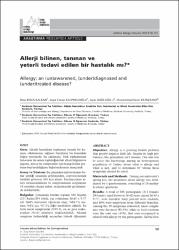| dc.contributor.author | Kalpaklioglu, A. | |
| dc.contributor.author | Kalkan, Koca, I | |
| dc.contributor.author | Daglioglu, A. | |
| dc.contributor.author | Kilinckaya, M. | |
| dc.date.accessioned | 2020-06-25T17:51:48Z | |
| dc.date.available | 2020-06-25T17:51:48Z | |
| dc.date.issued | 2011 | |
| dc.identifier.citation | Kalkan, K. İ., Kalpaklıoğlu, A. F., Dağlıoğlu, A., Kılınçkaya, M. F. (2011). Allerji bilinen, tanınan ve yeterli tedavi edilen bir hastalık mı?. Astım Allerji İmmünoloji, 9(3), 131 - 137. | en_US |
| dc.identifier.issn | 0105-4538 | |
| dc.identifier.issn | 1398-9995 | |
| dc.identifier.uri | https://hdl.handle.net/20.500.12587/4995 | |
| dc.description | 30th Congress of the European-Academy-of-Allergy-and-Clinical-Immunology (EAACI) -- JUN 11-15, 2011 -- Istanbul, TURKEY | en_US |
| dc.description | Kalpaklioglu, A. Fusun/0000-0002-6548-6932 | en_US |
| dc.description | WOS: 000329462201422 | en_US |
| dc.description.abstract | Allerjik hastalıklar toplumun önemli bir kısmını etkilemesine rağmen bireylerin bu konudaki bilgisi yetersizdir. Bu çalışmada, Türk toplumunun heterojen bir örnek topluluğundaki allerji bilgisini ve algısını, ayrıca bu semptomlar için hangi hekim grubuna başvurulduğunu değerlendirmeyi amaçladık. Gereç ve Yöntem: Bu çalışmaya üniversitemiz bahar şenliği sırasında şehrimizden, sosyoekonomik farklılık gösteren 505 kişi alındı. Katılımcıların allerji farkındalıklarını ve semptomlarını sorgulayan 18 sorudan oluşan anket, araştırmacılar gözetiminde doldurtuldu. Bulgular: Çalışmaya katılan toplam 505 kişinin (211 kadın/294 erkek, yaş ortalaması 26.65 ± 9.77 yıl) %60’ı üniversite öğrencisi olup, %28.7’si memur, %4’ü işçi, %7.3’ü diğer mesleklere dahildi. En fazla nazal semptomlar (%95.3), en az gıda reaksiyonları (%45) allerjiyle ilişkilendirildi. Allerjik semptom farkındalığı açısından yüksek öğrenimli bireylerle (%60.4) diğer öğrenim grupları arasında fark bulunmazken, sağlık alanında çalışan/öğrenim görenlerin (%12.1) allerjik solunumsal, nazal ve dermatolojik semptom farkındalığı yüksekti (sırasıyla p< 0.001, p= 0.025, p= 0.001). Allerjik olarak tanımlanan semptomlar için sırasıyla allerji (%33.7), göğüs hastalıkları (%24.4), kulak burun boğaz (%11.5) ve dermatoloji (%7.3)’ye başvurulacağı belirtildi. Eğitim düzeyleri açısından değerlendirildiğinde gruplar arasında fark görülmezken (p= 0.088), sağlık alanında çalışan/öğrenim görenlerin %49.1’i öncelikle allerji bölümüne başvurulacağının bilincindeydi (p= 0.016). Sonuç: Allerji konusunda toplum bilincini artırarak hastalığın semptomlarının, progresyonunun ve morbiditesinin azaltılabileceğine, ayrıca toplumun olduğu kadar mezuniyet öncesi ve sonrasında hekimlerin de sürekli ve tekrarlayıcı biçimde allerjik hastalıklar hakkında bilinçlendirilmesine ihtiyaç olduğunu düşünmekteyiz. | en_US |
| dc.description.abstract | Objective: Allergy is a growing health problem that greatly impacts daily life. Despite its high prevalence, the perception isn&#8217;t intense. Our aim was to assess the knowledge among an heterogenous population of Turkey about what is allergy and what is not, and to determine by whom those symptoms should be cared. Materials and Methods: During our university&#8217;s spring fest, the awareness about allergy was determined by a questionnaire, consisting of 18 multiple- choice questions. Results: A total of 505 participants (211 female/ 294 male), aged between 16-62 years (mean 26.65 ± 9.77), were enrolled. Sixty percent were students, and 40% were employees from different branches. Among the 19 symptoms evaluated, nasal complaints were the most (95.3%), while as food reactions were the least one (45%), that were recognized as related with allergy by the participants. Global awareness of allergy was not correlated with increased education level, but the awareness of respiratory, nasal and dermatologic symptoms were significantly higher in healthcare workers/students (p< 0.05). Of 439 participants with symptoms, who were complaining of impairment in daily activities, sleep problems, lack of school/work attendance of varying degrees, 25.5% had a doctor diagnosed allergic disease, most commonly rhinitis (7.9%) followed by asthma (5%). Of those with skin tested (18.1%), 28.3% was performed by an allergy specialist, 44.9% was found to be positive, but only 18.2% was prescribed an allergy medication. In case of suffering from allergic conditions, while as one third of the general population preferred to be cared by an allergologist, this was found to be significantly higher (49.1%) in a subgroup consisted of healthcare workers/students (p= 0.016). Conclusion: Increasing the awareness of allergic symptoms is the key not only for the diagnosis, but also for the optimal treatment of the disease. Therefore, continous/repetative education of medical staff is an important component of outreach for the prevention and control of allergen-induced diseases. | en_US |
| dc.description.sponsorship | European Acad Allergy & Clin Immunol (EAACI) | en_US |
| dc.language.iso | eng | en_US |
| dc.publisher | Wiley-Blackwell | en_US |
| dc.rights | info:eu-repo/semantics/closedAccess | en_US |
| dc.title | Allergy; an (un)awarened, (under)diagnosed and (under)treated disease? | en_US |
| dc.type | conferenceObject | en_US |
| dc.contributor.department | Kırıkkale Üniversitesi | en_US |
| dc.identifier.volume | 66 | en_US |
| dc.identifier.startpage | 315 | en_US |
| dc.identifier.endpage | 315 | en_US |
| dc.relation.journal | Allergy | en_US |
| dc.relation.publicationcategory | Konferans Öğesi - Uluslararası - Kurum Öğretim Elemanı | en_US |
















